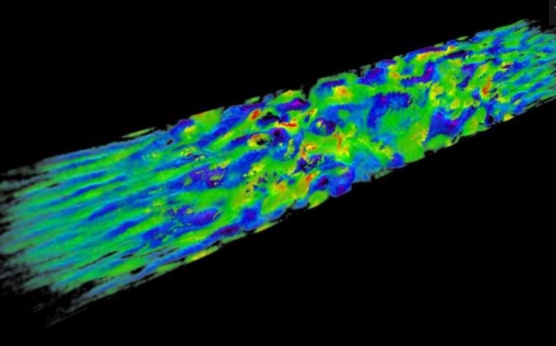Scientists use lasers to create miniature supernova shock waves on Earth

Researchers have created a miniature version of supernova shock waves in a lab here on Earth to solve a long-standing cosmic mystery.
When stars die and explode in supernovas, they create shock waves that emanate across the surrounding plasma. These powerful shock waves blast out cosmic rays, or highly energetic particles, out into the universe. The waves act almost like particle accelerators, pushing these particles out so fast that they approach the speed of light. However, scientists have yet to fully understand exactly how and why the shock waves accelerate these particles.
“These are fascinating systems, but because they are so far away it’s hard to study them,” Frederico Fiuza, a senior staff scientist at the Department of Energy’s SLAC National Accelerator Laboratory, who led the new study, said in a statement.
So, to better study these cosmic shock waves, scientists brought them to Earth. Well, not literally, but researchers have created a scaled-down version of supernova remnants. “We are not trying to make supernova remnants in the lab, but we can learn more about the physics of astrophysical shocks there and validate models,” Fiuza said in the statement.
Fiuza and his colleagues worked to create a fast, diffuse shock wave that could mimic the shocks that follow a supernova. The scientists worked at the National Ignition Facility, a Department of Energy facility at the Lawrence Livermore National Laboratory in California. At this facility, the researchers shot powerful lasers at carbon sheets to create two plasma flows, targeted at each other. When the plasma flows collided, they created a shock wave “in conditions similar to a supernova remnant shock,” according to the statement. The scientists observed the experiment using both optical and X-ray technology.
Chandra’s newly released image of Tycho supernova remnant reveals the dynamics of the stellar explosion that produced this deep-sky object in vivid detail. Image released July 22, 2014.
Chandra’s newly released image of Tycho supernova remnant reveals the dynamics of the stellar explosion that produced this deep-sky object in vivid detail. Image released July 22, 2014. (Image credit: NASA/CXC/SAO)
By studying a miniature analog of the cosmic phenomenon here on Earth, the researchers verified that the shock was capable of accelerating electrons to nearly the speed of light. However, the mystery of exactly how these electrons reached such speeds remains, which prompted the scientists to turn to computer modeling.
“We can’t see the details of how particles get their energy even in the experiments, let alone in astrophysical observations, and this is where the simulations really come into play,” Anna Grassi, a co-author on the new research also at SLAC, said in the same statement.
Now, while the cosmic mystery of the shock wave accelerated particles remains, computer models created by Grassi revealed one possible solution. According to these models, Grassi developed, turbulent electromagnetic fields within the shock wave could accelerate electrons to the speeds observed.
Fiuza, Grassi and their colleagues will continue to investigate the X-rays emitted by the accelerated electrons and hone their computer simulations, according to the statement. Other future research will study positively charged protons, in addition to the electrons studied in this work, blasted by the shock wave.



 Creators of mankind
Creators of mankind Description of “Tall white aliens”
Description of “Tall white aliens” Where they came from?
Where they came from? About hostile civilizations
About hostile civilizations The war for the Earth
The war for the Earth “Tall white aliens” about eternal life
“Tall white aliens” about eternal life Video: “Nordic aliens”
Video: “Nordic aliens” Aliens
Aliens Alien encounters
Alien encounters The aliens base
The aliens base UFO
UFO Technology UFO
Technology UFO Underground civilization
Underground civilization Ancient alien artifacts
Ancient alien artifacts Military and UFO
Military and UFO Mysteries and hypotheses
Mysteries and hypotheses Scientific facts
Scientific facts


















